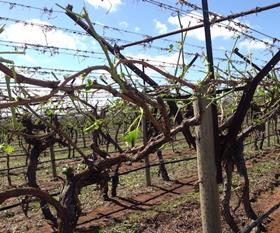
The freak storm that swept through Australia’s Mildura and Riverland regions on Friday 11 November has claimed an estimated 10-15 per cent of the country’s table grape crop, according to the latest estimates from the Australian Table Grape Association (ATGA).
“There was major damage,” confirmed CEO of the ATGA Jeff Scott. “We estimate losses of around 2m boxes for both domestic and export markets –that equates to around 10-15 per cent of total production.”
The Mildura area was hit by winds in excess of 90km per hour, along with heavy rain and hail, on the evening of 11 November. The 'mini tornado' cut a swath through Cardross, Red Cliffs and Paringi, with growers in the path of the hailstorm bearing the brunt of the damage.
“The storm just came through and stripped the vines,” Scott told Asiafruit. “Paringi alone lost around 750,000 boxes; it was wiped out. Some growers in Red Cliffs just got wind and rain, but it was the hail that did the damage.”
Altogether, ATGA estimates that around 80 growers were affected. “Some growers lost 100 per cent of their crops, others between 40 and 80 per cent,” he said. “To put this into perspective, these were mainly small family farmers with 35-45 acres.”
Offsetting the losses
Despite the devastating impact for certain growers, the damage was fairly isolated, and Scott believes the losses could be offset by new plantings coming into production this year.
“Our production has been increasing the past two or three years on the back of an increase in plantings, so new plantings coming on-stream will compensate for some of the losses,” he said. “Before the hail, growers were looking forward to a really big year, so we might be down slightly on original crop estimates, but not by much.”
Many growers in Mildura came through with minimal damage, while nearby Robinvale – the other key production hub – were unaffected, Scott added.
Export optimism
Australia heads into the new season on the back of a record 2016 export campaign, which saw around 110,000 tonnes exported – and key exporters remain bullish about the upcoming season.
“The damage certainly won’t derail the season,” said Ryan Smith of Valleyfresh Australia. “It might push up prices a bit and put pressure on the domestic market to secure fruit, especially with the US dollar exchange rate at 75 cents and export demand being so strong.”
The crop losses could, however, eat into the limited amount of fruit that’s likely to be available in time for Chinese New Year this year, he added. With the Australian grape season running around two weeks later, and Chinese New Year falling relatively early, on 28 January, in 2017, making the cut-off, even with fruit shipped by air, will be tight.
“The storm will remove a lot of the Ralli Seedless, as a lot of it’s grown in Cardross,” noted Smith. “China also buys a lot of Crimson out of Cardross.”
Scott said the industry is still hopeful of building on last year’s record export campaign. China remains the leading destination, followed by Indonesia and Hong Kong, but Japan has rapidly emerged as a very important market. Last year, which marked the second full season of access to Japan, shipments grew three-fold to around 10,000 tonnes. Currently, access is limited to three varieties – Thompson, Red Globe and Crimson – but Scott said the industry is now working to secure access for other varieties.
Heading off on a tour of key South East Asian markets this week, Scott described the export market access situation as good entering the new season, with all key markets open for business. “Our main focus now is on getting some improvements to our existing market access protocols,” he said. “We’ll be talking to importers and government agencies to see what we can do.”
Growers count costs
John Argiro, president of the Sunraysia Table Grape Growers Association, estimated the crop losses from the storm at some A$80-100m. While his own farms at Merbein just outside Mildura, weathered rain and wind, he said nearby growers in south Merbein, where the hailstorm started, were wiped out.
In addition to losing this year’s maturing crops, hail-hit growers also have grave concerns for next year’s production. As well as the canes bearing this year’s fruit, the vines were growing softer canes for next year’s crop. “Some growers have pruned these back hoping they will shoot buds, others are just hoping the canes will survive,” said Argiro.



